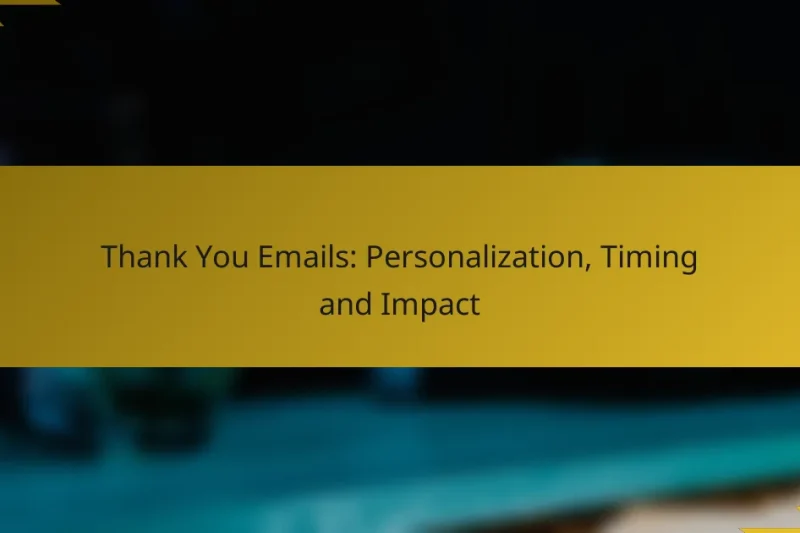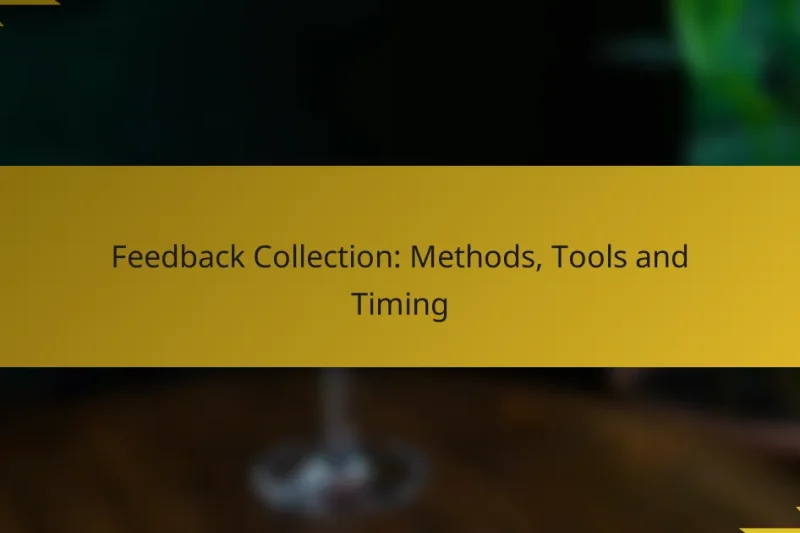Surveys are powerful tools for gathering insights, but their effectiveness hinges on thoughtful design, strategic distribution, … Surveys: Design, Distribution and InsightsRead more
Post-Event Analysis and Follow-Up
Post-event analysis and follow-up are crucial for understanding the effectiveness of an event and enhancing future planning. By systematically evaluating outcomes, gathering feedback, and measuring key performance metrics, organizers can identify successes and areas for improvement. Timely and personalized follow-up communication strengthens connections and fosters ongoing relationships, ultimately leading to greater opportunities.
ROI Measurement: Metrics, Analysis and Reporting
ROI measurement is a critical process that assesses the financial return generated from investments in relation … ROI Measurement: Metrics, Analysis and ReportingRead more
Thank You Emails: Personalization, Timing and Impact
Thank you emails are a powerful tool for building relationships and expressing gratitude. By personalizing your … Thank You Emails: Personalization, Timing and ImpactRead more
Social Proof: Testimonials, Case Studies and Engagement
Social proof plays a crucial role in boosting subscription engagement by fostering trust and credibility among … Social Proof: Testimonials, Case Studies and EngagementRead more
Attendance Analysis: Metrics, Trends and Insights
Attendance analysis is crucial for organizations aiming to enhance participant engagement and optimize event strategies. By … Attendance Analysis: Metrics, Trends and InsightsRead more
Follow-Up Campaigns: Strategies, Timing and Engagement
Follow-up campaigns are essential for sustaining engagement with your audience after initial interactions, ultimately enhancing customer … Follow-Up Campaigns: Strategies, Timing and EngagementRead more
Feedback Collection: Methods, Tools and Timing
Collecting feedback is essential for understanding user experiences and improving services or products. Various methods, such … Feedback Collection: Methods, Tools and TimingRead more
How to conduct effective post-event analysis?
Effective post-event analysis involves systematically evaluating the event’s outcomes to identify successes and areas for improvement. This process typically includes gathering data, assessing performance metrics, and collecting feedback from participants and stakeholders.
Data collection methods
Data collection methods are essential for gathering insights during post-event analysis. Common techniques include tracking attendance numbers, monitoring engagement levels, and reviewing event materials. Utilizing both qualitative and quantitative data can provide a comprehensive view of the event’s impact.
Consider using tools like event management software to streamline data collection. This can help automate attendance tracking and provide real-time analytics, making it easier to analyze the data later.
Key performance indicators
Key performance indicators (KPIs) are metrics that help evaluate the success of an event. Common KPIs include attendee satisfaction ratings, revenue generated, and social media engagement levels. Establishing clear KPIs before the event allows for focused analysis afterward.
When selecting KPIs, ensure they align with the event’s objectives. For example, if the goal was to increase brand awareness, metrics like social media reach and post-event website traffic would be relevant.
Stakeholder feedback
Collecting stakeholder feedback is crucial for understanding different perspectives on the event’s success. This can include insights from sponsors, speakers, and attendees. Engaging stakeholders in the analysis process fosters collaboration and can lead to valuable suggestions for future events.
Consider conducting one-on-one interviews or focus groups with key stakeholders to gather in-depth feedback. This qualitative approach can uncover insights that standard surveys might miss.
Surveys and questionnaires
Surveys and questionnaires are effective tools for gathering structured feedback from attendees. They can cover various aspects of the event, such as content quality, logistics, and overall satisfaction. Aim for concise surveys to encourage higher response rates.
Utilize online survey platforms to distribute questionnaires easily. Offering incentives, like discounts on future events, can also boost participation and provide more comprehensive data for analysis.
Social media monitoring
Social media monitoring allows event organizers to gauge public sentiment and engagement related to the event. Analyzing mentions, shares, and comments can provide insights into attendees’ perceptions and highlight areas for improvement.
Use social media analytics tools to track engagement metrics. This can help identify trends and popular topics, which can inform future event planning and marketing strategies.
What are best practices for follow-up communication?
Best practices for follow-up communication include being timely, relevant, and personalized. Effective follow-up helps reinforce connections made during the event and can lead to stronger relationships and future opportunities.
Personalized emails
Sending personalized emails is crucial for effective follow-up. Address recipients by name and reference specific conversations or interactions from the event to create a more engaging experience. This approach shows that you value their participation and fosters a sense of connection.
Consider segmenting your audience based on their interests or roles to tailor your messages further. For instance, if you hosted a conference, you might send different content to speakers, attendees, and sponsors, ensuring relevance for each group.
Thank you messages
Thank you messages are essential for expressing gratitude to attendees, speakers, and sponsors. A simple, heartfelt note can leave a lasting impression and encourage future engagement. Aim to send these messages within a few days of the event to maintain momentum.
Incorporate specific details about the recipient’s contribution or participation to make the message more meaningful. For example, thank a speaker for their insightful presentation and mention a key takeaway that resonated with the audience.
Event highlights recap
Providing an event highlights recap helps attendees remember key moments and insights. This can be in the form of a summary email, a blog post, or a social media update. Include highlights such as notable speakers, engaging sessions, and any important announcements.
Visual elements like photos or short video clips can enhance the recap and make it more engaging. Consider creating a downloadable PDF or a dedicated webpage that attendees can refer back to for detailed information.
Feedback requests
Requesting feedback is vital for improving future events and understanding attendee satisfaction. Create a brief survey that focuses on key aspects of the event, such as content quality, logistics, and overall experience. Aim for a completion time of just a few minutes to encourage participation.
Incentivizing feedback can also boost response rates. Consider offering a small prize or discount on future events as a thank you for completing the survey. This not only gathers valuable insights but also keeps your audience engaged with your brand.
How to measure event success?
Measuring event success involves analyzing various metrics that reflect attendance, engagement, and overall impact. Key indicators include attendance numbers, participant engagement levels, return on investment (ROI), and feedback from post-event surveys.
Attendance metrics
Attendance metrics are fundamental to evaluating event success, as they indicate how many people participated. Consider tracking total attendees, unique participants, and ticket sales to gauge interest and reach.
For example, if an event has 200 registered attendees but only 150 show up, the attendance rate is 75%. This figure can help you understand the effectiveness of your marketing efforts and the appeal of the event.
Engagement levels
Engagement levels reflect how actively participants interacted during the event. This can include session participation, networking activities, and social media interactions. High engagement often correlates with a successful event experience.
To measure engagement, track metrics such as session attendance, audience questions, and social media mentions. For instance, if 80% of attendees participate in Q&A sessions, it indicates strong interest and involvement.
ROI calculations
ROI calculations help determine the financial success of your event by comparing the costs incurred to the revenue generated. To calculate ROI, use the formula: (Net Profit / Total Costs) x 100.
For example, if your event costs $10,000 and generates $15,000 in revenue, your net profit is $5,000, resulting in an ROI of 50%. This metric is crucial for assessing the financial viability of future events.
Post-event surveys
Post-event surveys are essential for gathering feedback directly from attendees about their experiences. These surveys can provide insights into what worked well and what could be improved for future events.
Include questions about overall satisfaction, session quality, and suggestions for improvement. Aim for a response rate of at least 20-30% to ensure the feedback is representative. Analyzing this data can guide your planning for subsequent events.
What tools can assist in post-event analysis?
Several tools can significantly enhance post-event analysis by streamlining data collection, evaluation, and reporting. Utilizing the right combination of software can provide insights into attendee engagement, satisfaction, and overall event success.
Event management software
Event management software is essential for organizing and tracking various aspects of an event, including registration, ticket sales, and attendee engagement. These platforms often include built-in analytics features that help assess performance metrics like attendance rates and revenue generated.
When selecting event management software, consider factors such as user-friendliness, integration capabilities with other tools, and the specific analytics features offered. Popular options include Cvent, Eventbrite, and Whova, each providing unique functionalities to cater to different event types.
CRM systems
Customer Relationship Management (CRM) systems play a crucial role in post-event analysis by managing attendee data and interactions. They help track leads generated from the event and maintain relationships with attendees through targeted follow-up communications.
Choose a CRM that integrates well with your event management software to ensure seamless data flow. Salesforce and HubSpot are widely used CRMs that offer robust analytics and reporting features, allowing you to measure the impact of your event on customer engagement and sales.
Analytics platforms
Analytics platforms provide deeper insights into attendee behavior and event performance through data visualization and reporting tools. These platforms can analyze data from various sources, including social media engagement and website traffic, to give a comprehensive view of event success.
Consider platforms like Google Analytics or Tableau, which can help you track key performance indicators (KPIs) such as conversion rates and engagement levels. Setting up custom dashboards can help you monitor these metrics in real-time, enabling data-driven decisions for future events.
Survey tools
Survey tools are invaluable for gathering direct feedback from attendees about their experiences. Post-event surveys can assess satisfaction levels, gather suggestions for improvement, and measure the overall impact of the event.
Utilize tools like SurveyMonkey or Typeform to create engaging surveys that encourage responses. Aim for a mix of quantitative and qualitative questions to capture a well-rounded perspective. Keep surveys concise to improve completion rates, ideally taking no more than 5-10 minutes for attendees to finish.
What criteria should be used for evaluating feedback?
Evaluating feedback effectively requires focusing on criteria that align with the event’s objectives, the quality of insights provided, and the overall participant experience. Key factors include relevance, clarity, and actionable suggestions.
Relevance to objectives
Feedback relevance to the event’s objectives is crucial for determining its value. Assess how well the feedback aligns with the goals set before the event, such as participant engagement, knowledge transfer, or networking opportunities.
To evaluate relevance, categorize feedback based on specific objectives. For instance, if an event aimed to enhance skills, prioritize comments that address skill development over general observations. This helps in identifying actionable insights that can drive improvements.
Consider using a scoring system to rate feedback based on its relevance. A simple scale from 1 to 5 can help quantify how closely each piece of feedback aligns with the event’s objectives, enabling a more structured analysis.






